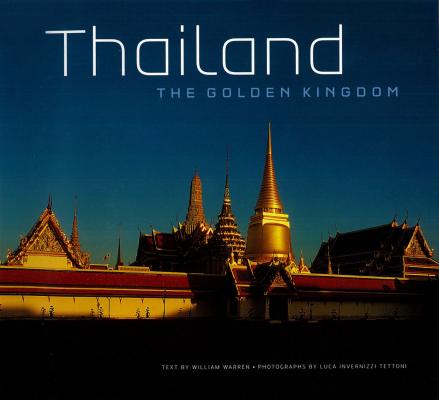ТОП просматриваемых книг сайта:
Thailand: The Golden Kingdom. William Warren
Читать онлайн.Название Thailand: The Golden Kingdom
Год выпуска 0
isbn 9781462909391
Автор произведения William Warren
Жанр Книги о Путешествиях
Издательство Ingram
Thailand
T H E G O L D E N K I N G D O M
Photography by Luca Invernizzi Tettoni
Text by William Warren
PERIPLUS
Published by Periplus Editions (HK) Ltd
Copyright © 1999 Periplus Editions (HK) Ltd
ALL RIGHTS RESERVED
ISBN: 978-1-4629-0939-1 (ebook)
Distributors
Indonesia:
PT Java Books Indonesia
Jl. Rawa Gelam IV No. 9 Kawasan Industri Pulogadung Jakarta 13930, Indonesia
Tel. 62 (21) 4382 1088 Tel. 62 (21) 461 0206 Email: [email protected]
Japan
Tuttle Publishing,
Yaekari Bldg., 3F; 5-4-12 Osaki, Shinagawa-ku; Tokyo 141- 0032,
Tel: (03) 5437 0171; Fax: (03) 5437 0755
Email: [email protected]
Asia Pacific:
Berkeley Books Pte. Ltd.
61 Tai Seng Avenue, #02-12 Singapore 534167.
Tel: (65) 6280 1330; Fax: (65) 6280 6290
Email: [email protected]
Website: www.periplus.com
North America, Latin America and Europe:
Tuttle Publishing,
364 Innovation Drive, North Clarendon, VT 05759-9436
Tel: (802) 773 8930; Fax: (802) 773 6993
Email: [email protected]
10 09 08 07
8 7 6 5
Printed in Singapore
The sacred white elephant, once a symbol of Thailand.
The spires of the Temple of the Emerald Buddha, within the compound of the Grand Palace.
Contents
History 12
Religion 38
Festivals 54
Introduction
"I do not know that these Siamese wats have beauty, which they say is reserved and aloof and very refined; all I know is that they are strange and gay and odd, their lines are infinitely distinguished, like the lines of a proposition in a schoolboy's Euclid, their colors are flaunting and crude, like the colors of vegetables in the greengrocer's stall at an open-air market, and, like a place where seven ways meet, they open roads down which the imagination can make many a careless and unexpected journey."
— Somerset Maugham, The Gentleman in the Parlor (1930)
Gold elephant dating from the 15th century, found in one of the old temples of Ayutthaya.
The ruins of Sukhothai, the first capital of Thailand, founded in the early 13th century.
The Grand Palace compound; the golden spires are part of the Temple of the Emerald Buddha.
Among Thailand's traditional crafts, one of the most striking is mosaics made of glass or ceramic-intricate patterns created by fitting thousands of small pieces together into what looks from a distance like a solid mass of vivid color, only revealing its separate parts at closer inspection. You can see this art brought to a peak of perfection in the dazzling precincts of the Temple of the Emerald Buddha in the Grand Palace or at the famous Temple of Dawn which raises its porcelain encrusted towers over the Chao Phraya River.
The technique may also be used as a metaphor for Thailand itself. For the kingdom, too, is made up of many different components, so closely connected it takes time and not a little effort to appreciate them individually.
Bangkok, the point of entry for most visitors, is a prime example. At first glance the capital city seems a typical modern metropolis-vast (sprawling over 960 square km), overcrowded (with a population of at least twelve million, probably more), boasting a network of elevated expressways and an international skyline of highrise office towers, hotels and shopping centers.
But look a little more carefully, not far behind this familiar Western facade, and you discover another, quite different city: It is one that encompasses Buddhist temples at once serene and spectacular; picturesque canals lined with open-fronted houses; colorful markets piled with exotic products; a Chinatown of narrow, clamorous alleyways; old Victorian palaces set in lush gardens; and a great river teeming with timeless traffic.
His Majesty King Bhumibol Adulyadej on his throne in the Grand Palace, beneath the royal umbrella.
In one of the many rituals associated with theatre in Thailand, two classical dancers pay homage to their teachers by lighting candles and incense sticks at a shrine.
Elsewhere, too, there is a similar co-existence of old and new, of cultural and scenic contrasts. Thailand is known as the "Land of the Free"; except for brief interludes in the 16th and 18th centuries, when the Burmese occupied the capital and other areas, it has always been proudly independent, undisturbed by colonial conquest and enjoying a degree of social and political unity rare among the countries of Southeast Asia. Yet, again, a closer look reveals surprising diversity.
Thais are not the only people who have chosen to make their home in this land of fertile rice fields, misty mountains and sunny sea coasts. There are sizeable communities of ethnic Lao, Chinese, Cambodians, Malays and Mons, as well as semi-nomadic tribal groups in the north-all of whom regard Thailand as home and all of whom have contributed in some way to its distinctive culture.
There are imposing ruins of ancient capitals and monuments-not only Thai but also Khmer and Mon-going back nearly 1,000 years, as well as much older traces of prehistoric cultures. There

